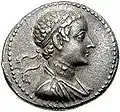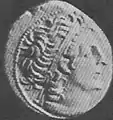Ptolemaic dynasty
The Ptolemaic dynasty (/ˌtɒlɪˈmeɪ.ɪk/; Ancient Greek: Πτολεμαῖοι, Ptolemaioi), sometimes referred to as the Lagid dynasty (Λαγίδαι, Lagidae; after Ptolemy I's father, Lagus), was a Macedonian Greek[1][2][3][4][5] royal dynasty which ruled the Ptolemaic Kingdom in Ancient Egypt during the Hellenistic period. Their rule lasted for 275 years, from 305 to 30 BC.[6] The Ptolemaic was the last dynasty of ancient Egypt.
| Ptolemaic dynasty | ||||||||||||||
|---|---|---|---|---|---|---|---|---|---|---|---|---|---|---|
Pharaoh Ptolemy Soter, British Museum | ||||||||||||||
 | ||||||||||||||
| Country | Ancient Egypt, Ancient Macedonia | |||||||||||||
| Founded | 305 BC | |||||||||||||
| Founder | Ptolemy I Soter | |||||||||||||
| Final ruler | Cleopatra VII and Ptolemy XV (Egypt) Ptolemy XVI (Syria) Ptolemy of Mauretania (Mauretania) | |||||||||||||
| Final head | Drusilla | |||||||||||||
| Titles | Pharaoh Basileus of Egypt King of Macedonia King of Mauretania King of Syria King of Cyrene | |||||||||||||
| Dissolution | AD 79 | |||||||||||||
| Deposition | 30 BC (Egypt) AD 40 (Mauretania) | |||||||||||||
| Periods and dynasties of ancient Egypt |
|---|
|
All years are BC |
|
See also: List of pharaohs by period and dynasty Periodization of ancient Egypt |
Ptolemy, one of the seven somatophylakes (bodyguard companions), a general and possible half-brother of Alexander the Great, was appointed satrap of Egypt after Alexander's death in 323 BC. In 305 BC, he declared himself Pharaoh Ptolemy I, later known as Sōter "Saviour". The Egyptians soon accepted the Ptolemies as the successors to the pharaohs of independent Egypt. Ptolemy's family ruled Egypt until the Roman conquest of 30 BC.
Like the earlier dynasties of ancient Egypt, the Ptolemaic dynasty practiced inbreeding including sibling marriage, but this did not start in earnest until nearly a century into the dynasty's history.[7] All the male rulers of the dynasty took the name Ptolemy, while queens regnant were all called Cleopatra, Arsinoe or Berenice. The most famous member of the line was the last queen, Cleopatra VII, known for her role in the Roman political battles between Julius Caesar and Pompey, and later between Octavian and Mark Antony. Her apparent suicide at the conquest by Rome marked the end of Ptolemaic rule in Egypt.
Ptolemaic rulers and consorts


%252C_da_hermitage.jpg.webp)



Dates in brackets represent the regnal dates of the Ptolemaic pharaohs. They frequently ruled jointly with their wives, who were often also their sisters, aunts or cousins. Several queens exercised regal authority. Of these, one of the last and most famous was Cleopatra ("Cleopatra VII Philopator", 51–30 BC), with her two brothers and her son serving as successive nominal co-rulers. Several systems exist for numbering the later rulers; the one used here is the one most widely employed by modern scholars.
- Ptolemy I Soter (303–282 BC)[10] married first Thaïs, then Artakama, then Eurydice, and finally Berenice I
- Ptolemy II Philadelphus (285–246 BC)[11] married Arsinoe I, then Arsinoe II; ruled jointly with Ptolemy Epigonos (267–259 BC)
- Ptolemy III Euergetes (246–221 BC) married Berenice II
- Ptolemy IV Philopator (221–203 BC) married Arsinoe III
- Ptolemy V Epiphanes (203–181 BC) married Cleopatra I Syra
- Ptolemy VI Philometor (181–164 BC, 163–145 BC) married Cleopatra II, briefly ruled jointly with Ptolemy Eupator in 152 BC
- Ptolemy VII Neos Philopator (possibly never reigned)
- Ptolemy VIII Physcon (170–163 BC, 145–116 BC) married Cleopatra II, then Cleopatra III; temporarily expelled from Alexandria by Cleopatra II from 131 to 127 BC, then reconciled with her in 124 BC.
- Cleopatra II Philometora Soteira (131–127 BC), in opposition to Ptolemy VIII Physcon
- Ptolemy Apion (c.120-96 BC), son of Ptolemy VIII. Last Ptolemaic king of Cyrene.
- Cleopatra III Philometor Soteira Dikaiosyne Nikephoros (Kokke) (116–101 BC) ruled jointly with Ptolemy IX Lathyros (116–107 BC) and Ptolemy X Alexander I (107–101 BC)
- Ptolemy IX Lathyros (116–107 BC, 88–81 BC as Soter II) married Cleopatra IV, then Cleopatra Selene; ruled jointly with Cleopatra III in his first reign
- Ptolemy X Alexander I (107–88 BC) married Cleopatra Selene, then Berenice III; ruled jointly with Cleopatra III till 101 BC
- Berenice III Philopator (81–80 BC)
- Ptolemy XI Alexander II (80 BC) married and ruled jointly with Berenice III before murdering her; ruled alone for 19 days after that.
- Ptolemy XII Neos Dionysos (Auletes) (80–58 BC, 55–51 BC) married Cleopatra V Tryphaena
- Cleopatra VI Tryphaena (58–57 BC) ruled jointly with Berenice IV Epiphaneia (58–55 BC), possibly identical with Cleopatra V Tryphaena[12]
- Cleopatra ("Cleopatra VII Philopator", 51–30 BC) ruled jointly with Ptolemy XIII Theos Philopator (51–47 BC), Ptolemy XIV (47–44 BC) and Ptolemy XV Caesarion (44–30 BC).
- Arsinoe IV (48–47 BC), in opposition to Cleopatra
- Ptolemy of Mauretania (13 or 9 BC–AD 40) Client king and ruler of Mauretania for Rome
Ptolemaic family tree
| Lagus of Eordea, Macedon | Arsinoe of Macedon | ||||||||||||||||||||||||||||||||||||||||||||||||||||
| Ptolemy I Soter (Kg 303–282 BC) | Berenice I | Philip | |||||||||||||||||||||||||||||||||||||||||||||||||||
| Arsinoe II | Ptolemy II Philadelphus (Kg. 285–246 BC) | Arsinoe I | Magas of Cyrene | Apama II | |||||||||||||||||||||||||||||||||||||||||||||||||
| Ptolemy III Euergetes (Kg. 246–221 BC) | Berenice II | ||||||||||||||||||||||||||||||||||||||||||||||||||||
| Ptolemy IV Philopator (Kg. 221–203 BC) | Arsinoe III | ||||||||||||||||||||||||||||||||||||||||||||||||||||
| Ptolemy V Epiphanes (Kg. 203–181 BC) | Cleopatra I Syra | ||||||||||||||||||||||||||||||||||||||||||||||||||||
| Ptolemy VI Philometor (Kg. 181–164 BC, 163–145 BC) | Cleopatra II (Qn. 131–127 BC) | Ptolemy VIII Physcon (Kg. 170–163 BC, 145–116 BC) | Eirene | ||||||||||||||||||||||||||||||||||||||||||||||||||
| Ptolemy VII Neos Philopator | Cleopatra III (Qn, 116–101 BC) | Ptolemy Memphites | Ptolemy Apion | ||||||||||||||||||||||||||||||||||||||||||||||||||
| Cleopatra IV | Ptolemy IX Lathyros (Kg. 116–107 BC, as Soter II 88–81 BC) | Cleopatra Selene | Ptolemy X Alexander I (Kg. 107–88 BC) | ||||||||||||||||||||||||||||||||||||||||||||||||||
| Ptolemy XII Auletes (Kg. 80–58 BC, 55–51 BC) | Berenice III (Qn. 81–80 BC) | Ptolemy XI Alexander II (Kg. 80 BC, for 19 days) | |||||||||||||||||||||||||||||||||||||||||||||||||||
| Cleopatra V (Qn. 58–55 BC) | |||||||||||||||||||||||||||||||||||||||||||||||||||||
| Cleopatra VI (Qn. 58 BC) | Berenice IV (Qn. 58–55 BC) | Ptolemy XIII Theos Philopator (Kg. 51–47 BC) | Cleopatra VII Thea Philopator (Qn. 51–30 BC) | Ptolemy XIV (Kg. 47–44 BC) | Arsinoe IV (Qn. 48–47 BC) | ||||||||||||||||||||||||||||||||||||||||||||||||
| Julius Caesar | Mark Antony | ||||||||||||||||||||||||||||||||||||||||||||||||||||
| Ptolemy XV Caesarion (Kg. 44–30 BC) | Alexander Helios | Ptolemy Philadelphus | Cleopatra Selene II | ||||||||||||||||||||||||||||||||||||||||||||||||||
| Ptolemy of Mauretania | |||||||||||||||||||||||||||||||||||||||||||||||||||||
| Detailed Ptolemaic family tree | |||||||||||||||||||||||||||||||||||||||||||||||||||||||||||||||||||||||||||||||||||||||||||||||||||||||||||||||||||||||||||||||||||||||||||||||||||||||||||||||||||||||||||||||||||||||||||||||||||||||||||||||||||||||||||||||||||||||||||||||||||||||||||||||||||||||||||||||||||||||||||||||||||||||||||||||||||||||||||||||||||||||||||||||||||||||||||||||||||||||||||||||||||||||||||||||||||||||||||||||||||||||||||||||||||||||||||||||||||||||||||||||||||||||||||||||||||||||||||||||||||||||||||||||||||||||||||||||||||||||||||||||||||||||||||||||||||||||||||||||||||||||||||||||||||||||||||||||||||||||||||||||||||||||||||||||||||||||||||||||||||||||||||||||||||||||||||||||||||||||||||||||||||||||||||||||||||||||||||||||||||||||||||||||||||||||||||||||||||||||||||||||||||||||||||||||||||||||||||||||||||||||||||||||||||||||||||||||||||||||||||||||||||||||||||||||||||||||||||||||||||||||||||||||||||||||||||||||||||||||||||||||||||||||||||||||||||||||||||||||||||||||||||||||||||||||||||||||||||||||
|---|---|---|---|---|---|---|---|---|---|---|---|---|---|---|---|---|---|---|---|---|---|---|---|---|---|---|---|---|---|---|---|---|---|---|---|---|---|---|---|---|---|---|---|---|---|---|---|---|---|---|---|---|---|---|---|---|---|---|---|---|---|---|---|---|---|---|---|---|---|---|---|---|---|---|---|---|---|---|---|---|---|---|---|---|---|---|---|---|---|---|---|---|---|---|---|---|---|---|---|---|---|---|---|---|---|---|---|---|---|---|---|---|---|---|---|---|---|---|---|---|---|---|---|---|---|---|---|---|---|---|---|---|---|---|---|---|---|---|---|---|---|---|---|---|---|---|---|---|---|---|---|---|---|---|---|---|---|---|---|---|---|---|---|---|---|---|---|---|---|---|---|---|---|---|---|---|---|---|---|---|---|---|---|---|---|---|---|---|---|---|---|---|---|---|---|---|---|---|---|---|---|---|---|---|---|---|---|---|---|---|---|---|---|---|---|---|---|---|---|---|---|---|---|---|---|---|---|---|---|---|---|---|---|---|---|---|---|---|---|---|---|---|---|---|---|---|---|---|---|---|---|---|---|---|---|---|---|---|---|---|---|---|---|---|---|---|---|---|---|---|---|---|---|---|---|---|---|---|---|---|---|---|---|---|---|---|---|---|---|---|---|---|---|---|---|---|---|---|---|---|---|---|---|---|---|---|---|---|---|---|---|---|---|---|---|---|---|---|---|---|---|---|---|---|---|---|---|---|---|---|---|---|---|---|---|---|---|---|---|---|---|---|---|---|---|---|---|---|---|---|---|---|---|---|---|---|---|---|---|---|---|---|---|---|---|---|---|---|---|---|---|---|---|---|---|---|---|---|---|---|---|---|---|---|---|---|---|---|---|---|---|---|---|---|---|---|---|---|---|---|---|---|---|---|---|---|---|---|---|---|---|---|---|---|---|---|---|---|---|---|---|---|---|---|---|---|---|---|---|---|---|---|---|---|---|---|---|---|---|---|---|---|---|---|---|---|---|---|---|---|---|---|---|---|---|---|---|---|---|---|---|---|---|---|---|---|---|---|---|---|---|---|---|---|---|---|---|---|---|---|---|---|---|---|---|---|---|---|---|---|---|---|---|---|---|---|---|---|---|---|---|---|---|---|---|---|---|---|---|---|---|---|---|---|---|---|---|---|---|---|---|---|---|---|---|---|---|---|---|---|---|---|---|---|---|---|---|---|---|---|---|---|---|---|---|---|---|---|---|---|---|---|---|---|---|---|---|---|---|---|---|---|---|---|---|---|---|---|---|---|---|---|---|---|---|---|---|---|---|---|---|---|---|---|---|---|---|---|---|---|---|---|---|---|---|---|---|---|---|---|---|---|---|---|---|---|---|---|---|---|---|---|---|---|---|---|---|---|---|---|---|---|---|---|---|---|---|---|---|---|---|---|---|---|---|---|---|---|---|---|---|---|---|---|---|---|---|---|---|---|---|---|---|---|---|---|---|---|---|---|---|---|---|---|---|---|---|---|---|---|---|---|---|---|---|---|---|---|---|---|---|---|---|---|---|---|---|---|---|---|---|---|---|---|---|---|---|---|---|---|---|---|---|---|---|---|---|---|---|---|---|---|---|---|---|---|---|---|---|---|---|---|---|---|---|---|---|---|---|---|---|---|---|---|---|---|---|---|---|---|---|---|---|---|---|---|---|---|---|---|---|---|---|---|---|---|---|---|---|---|---|---|---|---|---|---|---|---|---|---|---|---|---|---|---|---|---|---|---|---|---|---|---|---|---|---|---|---|---|---|---|---|---|---|---|---|---|---|---|---|---|---|---|---|---|---|---|---|---|---|---|---|---|---|---|---|---|---|---|---|---|---|---|---|---|---|---|---|---|---|---|---|---|---|---|---|---|---|---|---|---|---|---|---|---|---|---|---|---|---|---|---|---|---|---|---|---|---|---|---|---|---|---|---|---|---|---|---|---|---|---|---|---|---|---|---|---|---|---|---|---|---|---|---|---|---|---|---|---|---|---|---|---|---|---|---|---|---|---|---|---|---|---|---|---|---|---|---|---|---|---|---|---|---|---|---|---|---|---|---|---|---|---|---|---|---|---|---|---|---|---|---|---|---|---|---|---|---|---|---|---|---|---|---|---|---|---|---|---|---|---|---|---|---|---|---|---|---|---|---|---|---|---|---|---|---|---|---|---|---|---|---|---|---|---|---|---|---|---|---|---|---|---|---|---|---|---|---|---|---|---|---|---|---|---|---|---|---|---|
| |||||||||||||||||||||||||||||||||||||||||||||||||||||||||||||||||||||||||||||||||||||||||||||||||||||||||||||||||||||||||||||||||||||||||||||||||||||||||||||||||||||||||||||||||||||||||||||||||||||||||||||||||||||||||||||||||||||||||||||||||||||||||||||||||||||||||||||||||||||||||||||||||||||||||||||||||||||||||||||||||||||||||||||||||||||||||||||||||||||||||||||||||||||||||||||||||||||||||||||||||||||||||||||||||||||||||||||||||||||||||||||||||||||||||||||||||||||||||||||||||||||||||||||||||||||||||||||||||||||||||||||||||||||||||||||||||||||||||||||||||||||||||||||||||||||||||||||||||||||||||||||||||||||||||||||||||||||||||||||||||||||||||||||||||||||||||||||||||||||||||||||||||||||||||||||||||||||||||||||||||||||||||||||||||||||||||||||||||||||||||||||||||||||||||||||||||||||||||||||||||||||||||||||||||||||||||||||||||||||||||||||||||||||||||||||||||||||||||||||||||||||||||||||||||||||||||||||||||||||||||||||||||||||||||||||||||||||||||||||||||||||||||||||||||||||||||||||||||||||||
Other notable members of the Ptolemaic dynasty

- Ptolemy Keraunos (died 279 BC) – eldest son of Ptolemy I Soter. Eventually became king of Macedonia.
- Ptolemy Apion (died 96 BC) – son of Ptolemy VIII Physcon. Made king of Cyrenaica. Bequeathed Cyrenaica to Rome.
- Ptolemy Philadelphus (born 36 BC) – son of Mark Antony and Cleopatra VII.
- Ptolemy of Mauretania (died 40 AD) – son of King Juba II of Numidia and Mauretania and Cleopatra Selene II, daughter of Cleopatra VII and Mark Antony. King of Mauretania.
- Ptolemy II of Telmessos, grandson of Ptolemy Epigonos, flourished second half of 3rd century BC and first half of 2nd century BC
- Ptolemy of Cyprus, king of Cyprus c. 80–58 BC, younger brother of Ptolemy XII Auletes
Health
Continuing the tradition established by previous Egyptian dynasties, the Ptolemies engaged in inbreeding including sibling marriage, with many of the pharaohs being married to their siblings and often co-ruling with them.[14] Ptolemy I and other early rulers of the dynasty were not married to their relatives, the childless marriage of siblings Ptolemy II and Arsinoe II[15] being an exception. The first child-producing incestuous marriage in the Ptolemaic dynasty was that of Ptolemy IV and Arsinoe III, who were succeeded as co-pharaohs by their son Ptolemy V, born 210 BC. The most well-known Ptolemaic pharaoh, Cleopatra VII, was at different times married to and ruled with two of her brothers (Ptolemy XIII until 47 BC and then Ptolemy XIV until 44 BC), and their parents were likely siblings or possibly cousins as well.[7]
Contemporaries describe a number of the Ptolemaic dynasty members as extremely obese,[16] whilst sculptures and coins reveal prominent eyes and swollen necks. Familial Graves' disease could explain the swollen necks and eye prominence (exophthalmos), although this is unlikely to occur in the presence of morbid obesity. This is all likely due to inbreeding depression. In view of the familial nature of these findings, members of the Ptolemaic dynasty likely suffered from a multi-organ fibrotic condition such as Erdheim–Chester disease or a familial multifocal fibrosclerosis where thyroiditis, obesity and ocular proptosis may have all occurred concurrently.[17]
Gallery of images
 Ptolemy of Macedon founded the Ptolemaic Dynasty.
Ptolemy of Macedon founded the Ptolemaic Dynasty. Ptolemy II
Ptolemy II Ptolemy III
Ptolemy III Ptolemy IV
Ptolemy IV Ptolemy V
Ptolemy V_-_2009.jpg.webp) Ptolemy VI
Ptolemy VI Cleopatra II (right)
Cleopatra II (right) Ptolemy VIII
Ptolemy VIII Ptolemy IX
Ptolemy IX Ptolemy X
Ptolemy X Ptolemy XI
Ptolemy XI Ptolemy XII
Ptolemy XII Ptolemy XIII and Isis
Ptolemy XIII and Isis Ptolemy XIV
Ptolemy XIV Cleopatra VII
Cleopatra VII Ptolemy XV, commonly called Caesarion.
Ptolemy XV, commonly called Caesarion. Sardonyx cameo of a Ptolemaic prince as the Greek god Hermes, Cabinet des médailles, Paris.
Sardonyx cameo of a Ptolemaic prince as the Greek god Hermes, Cabinet des médailles, Paris.
See also
- Argead dynasty, another Greek dynasty in Egypt which ruled immediately prior to the Ptolemies
- Donations of Alexandria
- Hellenistic period
- History of ancient Egypt
- List of pharaohs#Ptolemaic Dynasty
- List of Seleucid rulers
- On Weights and Measures, which contains a chronology of the Ptolemies
- Ptolemaic Decrees
- Roman pharaohs
References
- Jones, Prudence J. (2006). Cleopatra: A Sourcebook. University of Oklahoma Press. p. 14. ISBN 9780806137414.
They were members of the Ptolemaic dynasty of Macedonians, who ruled Egypt after the death of its conqueror, Alexander the Great.
- Pomeroy, Sarah B. (1990). Women in Hellenistic Egypt. Wayne State University Press. p. 16.
while Ptolemaic Egypt was a monarchy with a Greek ruling class.
- Redford, Donald B., ed. (2000). The Oxford Encyclopedia of Ancient Egypt. Oxford University Press.
Cleopatra VII was born to Ptolemy XII Auletes (80–57 BC, ruled 55–51 BC) and Cleopatra, both parents being Macedonian Greeks.
- Bard, Kathryn A., ed. (1999). Encyclopedia of the Archaeology of Ancient Egypt. Routledge. p. 488. ISBN 9780415185899.
Ptolemaic kings were still crowned at Memphis and the city was popularly regarded as the Egyptian rival to Alexandria, founded by the Macedonians.
- Bard, Kathryn A., ed. (1999). Encyclopedia of the Archaeology of Ancient Egypt. Routledge. p. 687. ISBN 9780415185899.
During the Ptolemaic period, when Egypt was governed by rulers of Greek descent...
- Epiphanius of Salamis, however, puts the total number of years of the Ptolemaic dynasty at 306, presumably calculated from 306/5 BC to 1 AD. See: Epiphanius' Treatise on Weights and Measures – The Syriac Version (ed. James Elmer Dean), University of Chicago Press 1935, p. 28 (note 104). Compare On Weights and Measures.
- Move over, Lannisters: No one did incest and murder like the last pharaohs on The A.V. Club
- Walker, Susan; Higgs, Peter (2001), "Painting with a portrait of a woman in profile", in Walker, Susan; Higgs, Peter (eds.), Cleopatra of Egypt: from History to Myth, Princeton, N.J.: Princeton University Press (British Museum Press), pp. 314–315, ISBN 9780691088358.
- Fletcher, Joann (2008). Cleopatra the Great: The Woman Behind the Legend. New York: Harper. ISBN 978-0-06-058558-7, image plates and captions between pp. 246-247.
- Wasson, Donald (February 3, 2012). "Ptolemy I". World History Encyclopedia. Retrieved October 1, 2016.
- Tunny, Jennifer(2001)The Health of Ptolemy II Philadelphus. The Bulletin of the American Society of Papyrologists/ Vol.38(1/4), pp.119-134
- W. Huß, Ägypten in hellenistischer Zeit (Egypt in Hellenistic times). C. H. Beck, Munich 2001, p. 679
- Pfrommer, Michael; Towne-Markus, Elana (2001). Greek Gold from Hellenistic Egypt. Los Angeles: Getty Publications (J. Paul Getty Trust). ISBN 0-89236-633-8, pp. 22–23.
- Walter Scheidel (September 1996). "Brother-sister and parent-child marriage outside royal families in ancient Egypt and Iran: A challenge to the sociobiological view of incest avoidance?". Ethology and Sociobiology. 17 (5): 321. doi:10.1016/S0162-3095(96)00074-X.
- Ptolemy II "Philadelphus" on Encyclopædia Britannica
- Michalopoulos, A.; Tzelepis, G.; Geroulanos, S. (2003). ""Morbid obesity and hypersomnolence in several members of an ancient royal family"". Thorax. 58 (3): 281–282. doi:10.1136/thorax.58.3.281-b. PMC 1746609. PMID 12612315.
- Ashrafian, Hutan (2005). "Familial proptosis and obesity in the Ptolemies". J. R. Soc. Med. 98 (2): 85–86. doi:10.1177/014107680509800224. PMC 1079400. PMID 15684370.
Further reading
- A. Lampela, Rome and the Ptolemies of Egypt: The development of their political relations 273–80 B.C. (Helsinki, 1998).
- J. G. Manning, The Last Pharaohs: Egypt Under the Ptolemies, 305–30 BC (Princeton, 2009).
- Susan Stephens, Seeing Double: Intercultural Poetics in Ptolemaic Alexandria (Berkeley, 2002).
External links
- Livius.org: "Ptolemies"—by Jona Lendering
